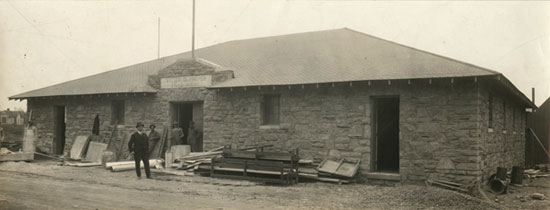Dec. 7, 2011
Commodore History Corner Archive
Nashville sports historian Bill Traughber has recently written another book, Vanderbilt Football: Tales of Commodore Gridiron History. The 160-page paperback book can be ordered on historypress.net for $19.99.

Photo of Walter O. Parmer Field House in 1922 just before its completion
There is a little-known part of Vanderbilt football history that has been seen by Commodore football fans for nearly nine decades, but largely ignored. Nestled in the north end zone underneath and to the side of the scoreboard near Section V of Dudley Field is an old stone building with a weathered roof of brownish-red tile.
This is the Walter O. Parmer Field House that was built in 1922 when Dudley Field and a new stadium was constructed. Parmer knew that the university needed locker rooms so he donated the funds for the building.
Parmer was born in 1855 and had to leave East Alabama Male College (now Auburn University) prior to the completion of his junior year to be with his ailing father, Dr. Clinton Dale Parmer. Upon his father’s eventual death in June 1873, Parmer took over the family business, as he was the oldest of five children. The family’s business interests were his father’s medical practice, half interest in Parmer & Webb Pharmacy and extensive farming acreage, which included raising thoroughbred horses.
In 1877, Parmer married Elizabeth Dunkin of Greenville, Ala. During the reconstruction era after the Civil War, Parmer served as a major in the Second Alabama Regiment of Volunteer Troops from 1877-1881. Parmer would sell most of the family’s mercantile interests and large cotton acreage partly due to the high taxes on a bale of cotton.
Parmer and his wife moved to Sumner County, Tenn., in 1883 where he purchased a 107-acre farm, which included thoroughbred horses. He conducted sales and auctioned stock during the period of 1885-1903. In 1907, Parmer sold that parcel of land and moved to a 600-acre piece of property on Gallatin Road in Nashville. This property had been an established thoroughbred horse-breeding farm. In the meantime, Parmer leased 400 acres of a western portion of the Belle Meade Plantation where his best thoroughbreds were stabled.
One of his business ventures in Nashville included a partnership with Bill Lyle. The partnership of Parmer & Lyle sold mules and horses at a barn on Broad and Second Avenue in downtown Nashville. This business interest lasted until at least 1910. During this time, Parmer joined a partnership that owned and developed a racecourse in Windsor, Ontario, across the border from Detroit. By 1911, Parmer was making $60,000 a year from this single investment.
Parmer’s growing wealth would place him in a position to become a director of the North Carolina and St. Louis Railroad and the Fort Meyers-Southern Railroad. He was also a board member of the American National Bank of Nashville, the American Securities Company, and the American Associates, Inc.
During World War I, Parmer transported his thoroughbreds to Lexington, Ky., and sold them at auction in 1917. Parmer purchased and raised cattle and hogs in an effort to provide more food for the war. At the conclusion of the World War I, Parmer would not return to thoroughbred breeding and stock farming, but devoted his time to other business opportunities.
While Parmer continued to live on his 600 acres in Nashville, he always wanted to purchase the Belle Meade Mansion, but was never successful. Then in 1916, Parmer was able to purchase the mansion with the 24 adjoining acres from Colonel Luke Lea at a public auction for $55,000. In previous years the Belle Meade land had been divided and sold in several parcels. Parmer made several renovations to the grounds’ buildings before moving in with his wife.
Parmer became a very generous philanthropist and his adopted hometown of Nashville benefited from his generosity. In 1922, when Vanderbilt constructed Dudley Field, Parmer donated the majority of the funds for a new field house. It was the dressing room for nearly 50 years for every Vanderbilt football player and visiting teams.
In the 1932 game with Tennessee, the field house gained attention when an overflowing crowd proceeded to locate seats atop the stone structure. The Tennessean gave this report:
And then the gate-crashing started. Between 2,000 and 3,000 frenzied persons stormed through the gate to the temporary north end bleachersâ€â€Âa surging wave of thundering humanity.
The blue coats had hardly checked the flow of humanity at the north end before another rush was made just east of the Parmer field house. This time several hundred, in lockstep style climbed onto the stone fence leading to the field house. Then they went on top of the equipment house and jumped into the north end bleacher section. They were stopped from jumping over but the top of Parmer field house looked like a crows nest, it was so black with humanity.
The blue coats were the police and the seating capacity at this time was 22,000 without the temporary bleachers. Dudley Field was just 10 years old at this time. That game ended in a 0-0 tie as the officials stopped the game late in the fourth quarter because they could not stop people from entering the sidelines and field.
Parmer was also chairman of the finance committee of the Athletic Association of Vanderbilt with several club memberships across the country including the Belle Meade Country Club. Parmer and his wife were not blessed with children and they always showed affection for his brothers and sisters and their children. Parmer died in Nashville in 1932 at age 72.
The Walter O. Parmer Scholarship Fund was established in 1936 and has provided scholarships for high school students in six Alabama counties. Students can gain a financial need scholarship for Vanderbilt, Auburn and the University of Alabama.
In recent years, the Parmer Field House has been the headquarters for the concessions at Vanderbilt’s sporting events. Since 1922 the Parmer Field House was the locker room for both the Commodores and their opponents. Vanderbilt dressed on one side while their opponents dressed on the other side with a wall separating the teams. The winning team could easily be heard whooping it up after a game. It wasn’t until the early 1970’s when the McGugin Center was built that the field house was no longer necessary.
The building was also the training room and office for Vanderbilt’s longtime trainer Joe Worden. The coaches also shared a small dressing room within the building. The baseball and track team would also dress in the facility.
“I was a student at Vanderbilt from 1956-60 on the Walter O. Parmer Scholarship which he first funded in 1936,” said Walter R. Parmer, the Chairman of the Parmer Scholarship Foundation and great-nephew of Parmer. “There doesn’t seem to be very many records around about the building. I wanted to see about possibly having the building converted to some type of museum, but I recently took a hard look at it and unfortunately it is in a state of not being repairable. That tile roof required massive support underneath it. Those supports have rotted now.
“The ceiling and everything is falling out. I’m not sure that it can be salvaged. The best thing might be to tear it down and put some plaque up saying this was the site of the former Walter O. Parmer Field House. I would suggest that we put a thoroughbred horse statue there since Parmer was a horse breeder and a racetrack entrepreneur. That is where he made his fortune. That might be the best way to honor his legacy instead of trying to restore it.”
In November 1988, sports writer John Bibb of the Tennessean wrote a column about the aging Parmer Field House suggesting that one day the building would be ideal for housing a Vanderbilt Sports Hall of Fame. During the stadium’s renovations in 1981, architects and engineers were told to make plans to keep the historic building and figure a way to keep it in the event the north end zone horseshoe was ever enclosed to match the south end zone.
Vanderbilt’s Athletics Director at that time was Roy Kramer and he gave this view on the Parmer Field House for Bibb’s story:
“In my relatively short time at Vanderbilt, since 1978, I’ve come to appreciate the Parmer building and what it means to so many students. I’d love to see it preserved and I intend to make every effort to leave it intact. The coaches’ quarters, players’ lockers, showers, training and equipment rooms remain, as they were the day the athletes moved into McGugin.
“I’m told Coach Jess Neely used Parmer when he was captain of the Commodores. It would be a marvelous gathering place for our former athletes and students. I’d like to see it developed as a shrine, housing memorabilia of other days of Vanderbilt athletics.”
In Bibb’s 1988 story he referred to the Walter O. Parmer Field House as “an old friend.” The “old friend” is now 89 years old and a part of the Vanderbilt campus history with a future in doubt.
If you have any comments or suggestions you can contact Bill Traughber via email at WLTraughber@aol.com.


